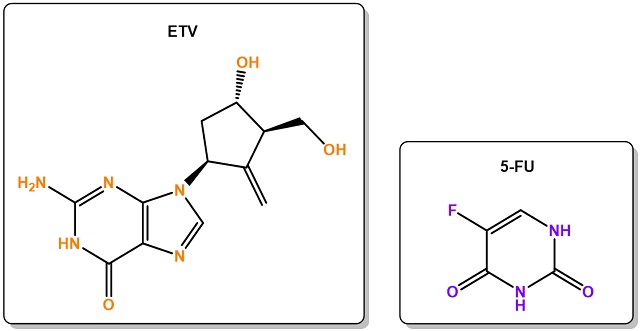Nikhil Prasad Fact checked by:Thailand Medical News Team Jul 22, 2024 9 months, 4 days, 6 hours, 45 minutes ago
Cancer Updates: Researchers from the University of Porto-Portugal have made a groundbreaking discovery in the fight against prostate and bladder cancer. Their recent study explores the synergistic potential of combining two drugs, Entecavir (ETV) and 5-Fluorouracil (5-FU), and the results are promising. This
Cancer Updates news report delves into their findings and what it means for cancer treatment.
 Chemical structures of drugs Entecavir (ETV) and 5-Fluorouracil (5-FU)
The Challenge of Cancer Treatment
Chemical structures of drugs Entecavir (ETV) and 5-Fluorouracil (5-FU)
The Challenge of Cancer Treatment
Prostate and bladder cancers are among the most common malignancies affecting men worldwide. Traditional treatments, such as surgery, chemotherapy, and radiation, often come with severe side effects and the risk of resistance, making them less effective over time. Researchers are constantly seeking new ways to improve these treatments and reduce their drawbacks.
The Study and Its Objectives
In this quest for better treatments, a team led by Dr Tânia Lourenço, Dr Lara Marques, Dr Eduarda Ribeiro, and Dr Nuno Vale from the University of Porto investigated the effects of ETV and 5-FU, both alone and in combination, on prostate and bladder cancer cells. Their goal was to find a drug combination that could enhance treatment efficacy while minimizing side effects.
What is Entecavir?
Entecavir (ETV) is an antiviral drug primarily used to treat hepatitis B. However, it has shown potential in inhibiting certain enzymes linked to cancer progression. This study aimed to repurpose ETV for cancer treatment, exploring its effects on prostate and bladder cancer cells.
What is 5-Fluorouracil?
5-Fluorouracil (5-FU) is a well-known chemotherapy drug used to treat various cancers, including colorectal, gastric, and breast cancers. It works by interfering with the DNA synthesis of cancer cells, thereby inhibiting their growth. Although effective, 5-FU is associated with significant side effects and resistance issues.
Methodology
The research team conducted a series of experiments on PC-3 (prostate cancer) and UM-UC-5 (bladder cancer) cell lines. They tested different concentrations of ETV and 5-FU, both individually and in combination, over various time periods (24, 48, and 72 hours). They assessed cell viability, proliferation, and cytotoxicity using the MTT assay, a colorimetric assay for assessing cell metabolic activity.
Key Findings
The study revealed several crucial findings:
-ETV's Cytotoxic Effects: ETV alone demonstrated significant cytotoxic effects on prostate cancer cells (PC-3), reducing their viability considerably. This was particularly evident at higher concentrations and longer exposure times.
-5-FU's Efficacy: While 5-FU also reduced cell viability, its effects were more prono
unced in concentrations equal to or greater than 10 µM. The IC50 (concentration required to inhibit cell viability by 50%) for 5-FU was determined to be 3.22 µM for prostate cancer cells.
-Synergistic Potential: The combination of ETV and 5-FU showed promising results, particularly in the 72-hour study. The combination was more effective in reducing cell viability than either drug alone. Notably, the 50 µM concentration of ETV combined with the IC50 value of 5-FU produced significant cytotoxic effects on prostate cancer cells.
-Bladder Cancer Cells: For bladder cancer cells (UM-UC-5), ETV alone did not produce significant cytotoxic effects. However, the combination of ETV and 5-FU showed some potential, particularly at lower concentrations of ETV combined with the IC50 value of 5-FU.
Implications for Cancer Treatment
These findings suggest that the combination of ETV and 5-FU could be a promising new approach to treating prostate cancer, potentially offering better outcomes than current treatments. The synergistic effect observed indicates that lower doses of each drug could be used, reducing the risk of severe side effects and overcoming resistance.
Future Directions
While the results are promising, further studies are needed to confirm these findings and explore the mechanisms behind the observed effects. The research team plans to conduct additional experiments to better understand how ETV and 5-FU interact at the molecular level and to evaluate their effectiveness in other cancer types.
Conclusion
The study conducted by researchers from the University of Porto provides new hope for prostate and bladder cancer patients. By repurposing the antiviral drug ETV and combining it with 5-FU, they have uncovered a potentially powerful treatment strategy. This approach not only enhances the efficacy of existing treatments but also addresses the challenges of side effects and resistance.
The study findings were published in the peer-reviewed journal BioMed.
https://www.mdpi.com/2673-8430/4/2/15
For the
Cancer Updates, keep on logging to Thailand Medical News.
Read Also:
https://www.thailandmedical.news/news/new-genetic-risk-factors-for-prostate-cancer-discovered
https://www.thailandmedical.news/news/herbs-and-phytochemicals-german-study-shows-that-mistletoe-extracts-inhibit-bladder-cancer-cell-growth-and-proliferation
